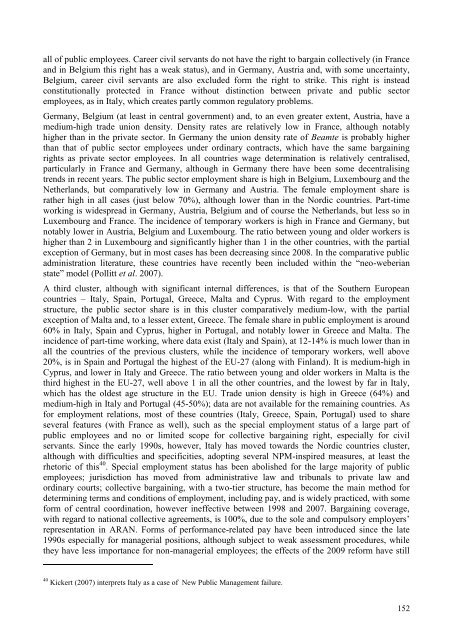Industrial Relations in Europe 2012 - European Commission - Europa
Industrial Relations in Europe 2012 - European Commission - Europa
Industrial Relations in Europe 2012 - European Commission - Europa
You also want an ePaper? Increase the reach of your titles
YUMPU automatically turns print PDFs into web optimized ePapers that Google loves.
all of public employees. Career civil servants do not have the right to barga<strong>in</strong> collectively (<strong>in</strong> France<br />
and <strong>in</strong> Belgium this right has a weak status), and <strong>in</strong> Germany, Austria and, with some uncerta<strong>in</strong>ty,<br />
Belgium, career civil servants are also excluded form the right to strike. This right is <strong>in</strong>stead<br />
constitutionally protected <strong>in</strong> France without dist<strong>in</strong>ction between private and public sector<br />
employees, as <strong>in</strong> Italy, which creates partly common regulatory problems.<br />
Germany, Belgium (at least <strong>in</strong> central government) and, to an even greater extent, Austria, have a<br />
medium-high trade union density. Density rates are relatively low <strong>in</strong> France, although notably<br />
higher than <strong>in</strong> the private sector. In Germany the union density rate of Beamte is probably higher<br />
than that of public sector employees under ord<strong>in</strong>ary contracts, which have the same barga<strong>in</strong><strong>in</strong>g<br />
rights as private sector employees. In all countries wage determ<strong>in</strong>ation is relatively centralised,<br />
particularly <strong>in</strong> France and Germany, although <strong>in</strong> Germany there have been some decentralis<strong>in</strong>g<br />
trends <strong>in</strong> recent years. The public sector employment share is high <strong>in</strong> Belgium, Luxembourg and the<br />
Netherlands, but comparatively low <strong>in</strong> Germany and Austria. The female employment share is<br />
rather high <strong>in</strong> all cases (just below 70%), although lower than <strong>in</strong> the Nordic countries. Part-time<br />
work<strong>in</strong>g is widespread <strong>in</strong> Germany, Austria, Belgium and of course the Netherlands, but less so <strong>in</strong><br />
Luxembourg and France. The <strong>in</strong>cidence of temporary workers is high <strong>in</strong> France and Germany, but<br />
notably lower <strong>in</strong> Austria, Belgium and Luxembourg. The ratio between young and older workers is<br />
higher than 2 <strong>in</strong> Luxembourg and significantly higher than 1 <strong>in</strong> the other countries, with the partial<br />
exception of Germany, but <strong>in</strong> most cases has been decreas<strong>in</strong>g s<strong>in</strong>ce 2008. In the comparative public<br />
adm<strong>in</strong>istration literature, these countries have recently been <strong>in</strong>cluded with<strong>in</strong> the “neo-weberian<br />
state” model (Pollitt et al. 2007).<br />
A third cluster, although with significant <strong>in</strong>ternal differences, is that of the Southern <strong>Europe</strong>an<br />
countries – Italy, Spa<strong>in</strong>, Portugal, Greece, Malta and Cyprus. With regard to the employment<br />
structure, the public sector share is <strong>in</strong> this cluster comparatively medium-low, with the partial<br />
exception of Malta and, to a lesser extent, Greece. The female share <strong>in</strong> public employment is around<br />
60% <strong>in</strong> Italy, Spa<strong>in</strong> and Cyprus, higher <strong>in</strong> Portugal, and notably lower <strong>in</strong> Greece and Malta. The<br />
<strong>in</strong>cidence of part-time work<strong>in</strong>g, where data exist (Italy and Spa<strong>in</strong>), at 12-14% is much lower than <strong>in</strong><br />
all the countries of the previous clusters, while the <strong>in</strong>cidence of temporary workers, well above<br />
20%, is <strong>in</strong> Spa<strong>in</strong> and Portugal the highest of the EU-27 (along with F<strong>in</strong>land). It is medium-high <strong>in</strong><br />
Cyprus, and lower <strong>in</strong> Italy and Greece. The ratio between young and older workers <strong>in</strong> Malta is the<br />
third highest <strong>in</strong> the EU-27, well above 1 <strong>in</strong> all the other countries, and the lowest by far <strong>in</strong> Italy,<br />
which has the oldest age structure <strong>in</strong> the EU. Trade union density is high <strong>in</strong> Greece (64%) and<br />
medium-high <strong>in</strong> Italy and Portugal (45-50%); data are not available for the rema<strong>in</strong><strong>in</strong>g countries. As<br />
for employment relations, most of these countries (Italy, Greece, Spa<strong>in</strong>, Portugal) used to share<br />
several features (with France as well), such as the special employment status of a large part of<br />
public employees and no or limited scope for collective barga<strong>in</strong><strong>in</strong>g right, especially for civil<br />
servants. S<strong>in</strong>ce the early 1990s, however, Italy has moved towards the Nordic countries cluster,<br />
although with difficulties and specificities, adopt<strong>in</strong>g several NPM-<strong>in</strong>spired measures, at least the<br />
rhetoric of this 40 . Special employment status has been abolished for the large majority of public<br />
employees; jurisdiction has moved from adm<strong>in</strong>istrative law and tribunals to private law and<br />
ord<strong>in</strong>ary courts; collective barga<strong>in</strong><strong>in</strong>g, with a two-tier structure, has become the ma<strong>in</strong> method for<br />
determ<strong>in</strong><strong>in</strong>g terms and conditions of employment, <strong>in</strong>clud<strong>in</strong>g pay, and is widely practiced, with some<br />
form of central coord<strong>in</strong>ation, however <strong>in</strong>effective between 1998 and 2007. Barga<strong>in</strong><strong>in</strong>g coverage,<br />
with regard to national collective agreements, is 100%, due to the sole and compulsory employers’<br />
representation <strong>in</strong> ARAN. Forms of performance-related pay have been <strong>in</strong>troduced s<strong>in</strong>ce the late<br />
1990s especially for managerial positions, although subject to weak assessment procedures, while<br />
they have less importance for non-managerial employees; the effects of the 2009 reform have still<br />
40 Kickert (2007) <strong>in</strong>terprets Italy as a case of New Public Management failure.<br />
152

















